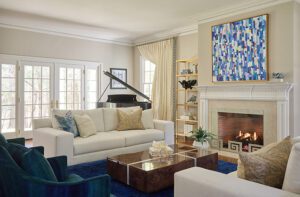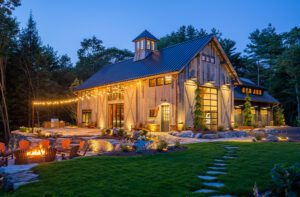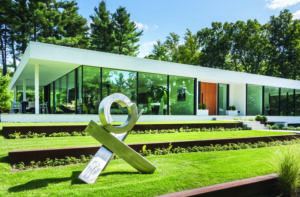Made in the Shade
August 26, 2010
Text by Robert Kiener Photography by Robert Benson
In the beginning was the tree. And the tree was very good. In this case, the tree was a majestic oak that towered over a stately home for sale on a glorious two-acre lot overlooking the Newport, Rhode Island’s Sakonnet River. “I fell in love with that oak the minute I saw it,” confesses the home’s owner. “I knew that whatever we did, whether we expanded the original home or built our own, no one would ever touch that tree.”
And no one did. After they bought the house and the adjacent two acres, the owner and his wife reluctantly decided they needed to raze the structure and build a new home in its place. “But I was adamant that the oak, and other trees on the lot, be protected,” says the husband, who is a noted real estate developer. His wife agrees, adding, “We wanted our new home to look as if it had been there for ages. We wanted it to blend in with the land; we didn’t want to cut down trees and build a McMansion.”
To realize their vision, the couple enlisted the help of two Boston-based pros: architect James Cullion and interior designer Eileen Marcuvitz. Cullion is known as someone who excels at investigating, questioning and listening to his clients’ wants and needs to produce a home that is uniquely suited to them. “The couple told me they wanted a home that was welcoming, romantic and graceful,” says Cullion. “They wanted a family home, not a monument.”
To get a better idea of what his clients wanted, Cullion and the husband drove around Newport on an impromptu architectural tour. “He pointed out things he liked,” explains Cullion, “such as a massive stone chimney, interesting rooflines, an elegant oversize front door, decorative roof cresting on a Queen Anne, as well as things he didn’t like. That was invaluable. I also learned that he and his wife value designs that emphasize symmetry and proportion.”
Taking his cue from the owner’s love for the oak, Cullion incorporated it as an integral part of his design. “It balances the local-stone chimney and also serves to welcome visitors into the house,” says Cullion. “It’s no exaggeration to say that the house was literally designed around the oak.”
The main body of the house is also an exercise in symmetry, with a large central gable flanked by two turrets. “I also varied the roofline to break down the scale of the house and make it more residential as opposed to being big for big’s sake,” says Cullion.
The arched eyebrow portico over the front door was partly inspired by a similar example the owner pointed out to Cullion on their drive. “The arch is inherently welcoming; it’s a shape we used throughout the home,” says Cullion. The wide mahogany front door, for example, is topped with an arch that echoes the portico. The arch shape reappears several times inside the home.
To soften the approach to the five-bedroom, 10,000-plus-square-foot house, a bluestone walkway through a garden of purple and white annuals and perennials was set at forty-five degrees. “We didn’t want an overpowering entryway,” explains the wife. “We want guests to feel relaxed and welcome as they walk through the garden to the front porch.”
Nothing was left to chance. The couple even hired a certified arborist to catalog and inspect the tress on the property and visit the site once a week during the house’s two-year construction to make sure trees stayed undamaged. “It would have been a lot less expensive and easier during construction if we chopped down the oak,” the husband says. “In fact, my contractor and I fought over that tree once a week. But the tree won!”
Because the pair brought nothing from their former home, also in Newport, designer Marcuvitz had a blank slate. On board from the beginning, Marcuvitz worked closely with Cullion to help incorporate the wife’s wishes into both design and decoration. Much of the furniture is custom made, some designed by Marcuvitz herself.
“My first concern was to take full advantage of the home’s breathtaking views across lushly landscaped, rolling acres to the water,” says the designer. Water and light were her starting points. “I used a palette of misty blues with hints of sea and sky. I wanted to bring the outside inside.”
For example, the living room wall is painted sea grass green; the richly paneled landing is given a coat of white the color of sailcloth. “I chose pale, watery colors overall and this helps the colors flow from one room to the other,” says Marcuvitz. “It also gives a symmetry to the design.” The radiant-heated floors are quarter-sawn five-inch bleached white oak.
Because the owners wanted a clean, elegant feel to the design, Marcuvitz avoided jarring patterns. “I wanted these rooms to be restful to the eye,” she says. “I get interest by using sculptural shapes in the furniture selection.”
Marcuvitz consulted with the wife on every detail. “And that includes the covers for the Kleenex boxes,” says Marcuvitz with a smile. “Invariably when people come into this house they say every detail has been so well thought out. But nothing hits you in the face; it’s all clean, elegant and lovely.”
Local builder Doug Shear used structural insulated panels to construct the house instead of traditional stick framing. The engineered panels, 6.5-inch thick sandwiches of polystyrene and plywood, arrive on site with everything from window openings and electrical sockets already cut out, so installation is quicker than traditional framing methods. “They are also very energy efficient,” notes Shear. Indeed, the home is so tight that the owner didn’t even turn on the heat in half the house last winter.
The owners are thrilled with their new home. “This was an incredibly successful collaboration,” says the wife. “We got all the romance, elegance and welcoming feel we had hoped for, and more.”
The husband is fond of telling a story about the cocktail party he and his wife held as a housewarming. They invited their new neighbors and everyone involved in creating the house. As the guests were leaving, one of them turned to the couple and said, “It’s amazing. This house looks like it has always been here. It really looks like it was dropped in place from above. So glad you saved the oak.”
Says the husband: “Nothing could have made me happier.”
Architecture: James Cullion
Interior design: Eileen Marcuvitz, Plum Interiors
Landscape architecture: Sharon Mooney
Builder: Doug Shear, Newport Housewrights
Share
![NEH-Logo_Black[1] NEH-Logo_Black[1]](https://www.nehomemag.com/wp-content/uploads/2022/08/NEH-Logo_Black1-300x162.jpg)
























You must be logged in to post a comment.